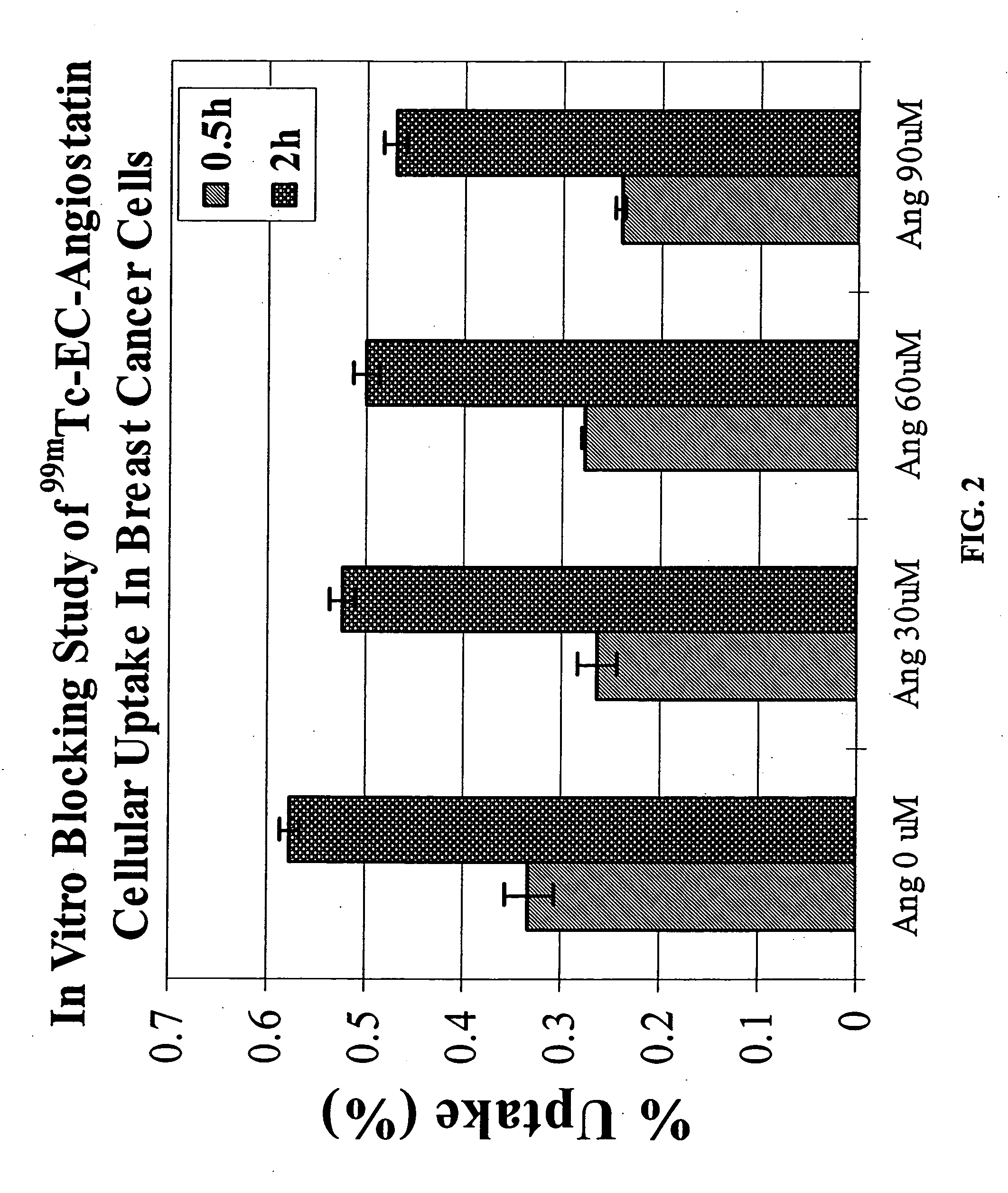N2S2 chelate-targeting ligand conjugates
- Summary
- Abstract
- Description
- Claims
- Application Information
AI Technical Summary
Benefits of technology
Problems solved by technology
Method used
Image
Examples
example 1
Targeting Integrin (αvβ3) with EC-Angiostatin
[0152] a. Synthesis of Ethylenedicysteine (EC)
[0153] Integrin (αvβ3) is a disease angiogenic target that can be targeted with EC-angiostatin, a compound of the present invention. EC was prepared in a two-step synthesis according to the previously described methods (Ratner and Clarke, 1937; Blondeau et al., 1967; each incorporated herein by reference). The precursor, L-thiazolidine-4-carboxylic acid, was synthesized (m.p. 195°, reported 196-197°). EC was then prepared (m.p. 237°, reported 251-253°). The structure was confirmed by 1H-NMR and fast-atom bombardment mass spectroscopy (FAB-MS).
[0154] b. Radiosynthesis of 99mTc-EC-Angiostatin
[0155] Sodium bicarbonate (1N, 1 ml) was added to a stirred solution of EC (3.27 mg, 12.2 μmol). To this colorless solution, sulfo-N-hydroxysulfosuccinimide (Sulfo-NHS, Pierce Chemical Co., Radford, Ill.) (3.0 mg, 13.8 mmol) and 1-ethyl-3-(3-dimethylaminopropyl) carbodiimide (EDC, 2.0 mg, 10.5 μmol) (Ald...
example 2
Targeting EGFR with EC-C225 Monoclonal Antibody
[0162] a. Radiosynthesis of 99mTc-EC-C225
[0163] EGFR is a disease angiogenic target that can be targeted with 99mTc-EC-C225 monoclonal antibody, a compound of the present invention. Clinical grade anti-EGF receptor R MAb C225 (IMC-C225) was obtained from ImClone Systems, Inc. (Somerville, N.J.). C225 (20 mg) was stirred with EC (28.8 mg, 0.11 mmol in 1.4 ml of 1N NaHCO3), sulfo-NHS (23.3 mg, 0.11 mmol) and EDC (16.6 mg, 0.09 mmol). After dialysis, 17 mg of EC-C225 was obtained. 100 mCi of Na99mTcO4 was added into a vial containing 1 mg EC-C225 and 100 μg SnCl2 and the product was purified with a G-25 column and eluted with PBS, yielded 80 mCi 99mTc-EC-C225. Radiochemical purity for 99mTc-EC-C225 was 100% (HPLC, gel permeation column, 0.1% LiBr in 100 mM PBS, pH 7.4). Specific activity was 2 Ci / μmol (FIG. 7).
[0164] For example, an immunoassay (Western Blot and Immunoprecipitation) and cell proliferation assays were used to examine the...
example 3
Targeting COX-2 Enzyme with EC-Celecoxib
[0169] a. Synthesis of Ethylamino Celecoxib (EA-Celecoxib)
[0170] The COX-2 enzyme is a disease angiogenic target that can be targeted with EC-celecoxib, a compound of the present invention. N-4-(5-p-tolyl-3-trifluoromethyl-pyrazol-1-yl)benzenesulfonylamide (celecoxib) (114.4 mg, 0.3 mmol) was dissolved in chloroform (2 ml). To this solution, DBU 44.9 μl (0.3 mmol in chloroform 0.5 ml) and ethyl isocyanatoacetate 33.741 (0.3 mmol in chloroform 0.5 ml) were added. The reaction was stirred at room temperature for 6 hours. The solvent was evaporated under vacuo. The product was isolated from silica gel-packed column using chloroform / methanol as an eluant. The yield of the ester form of celecoxib (compound I) was 135 mg (88.1%). The synthetic scheme is shown in FIG. 13. NMR spectra data was recorded in FIG. 14.
[0171] Compound I (102 mg, 0.2 mmol) was dissolved in 2 ml of methanol and ethylene diamine (72.9 μl) was added. The reaction was stirred...
PUM
| Property | Measurement | Unit |
|---|---|---|
| Current | aaaaa | aaaaa |
| Fraction | aaaaa | aaaaa |
| Fraction | aaaaa | aaaaa |
Abstract
Description
Claims
Application Information
 Login to View More
Login to View More - R&D
- Intellectual Property
- Life Sciences
- Materials
- Tech Scout
- Unparalleled Data Quality
- Higher Quality Content
- 60% Fewer Hallucinations
Browse by: Latest US Patents, China's latest patents, Technical Efficacy Thesaurus, Application Domain, Technology Topic, Popular Technical Reports.
© 2025 PatSnap. All rights reserved.Legal|Privacy policy|Modern Slavery Act Transparency Statement|Sitemap|About US| Contact US: help@patsnap.com



